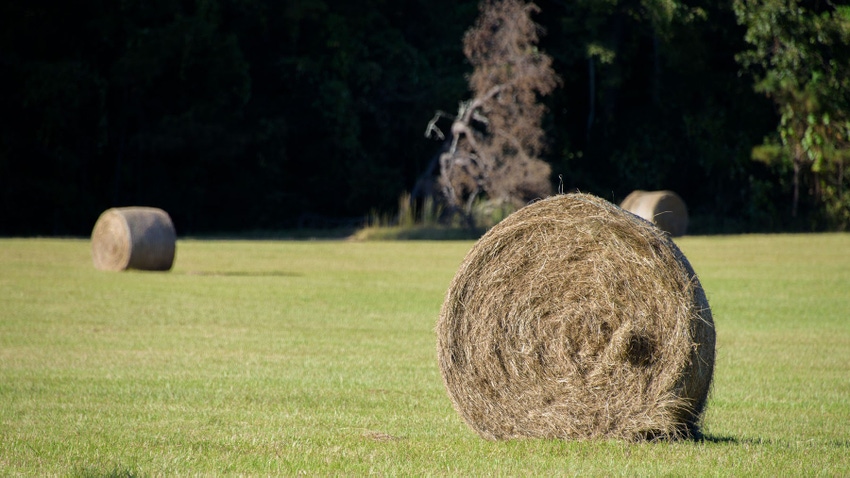October 31, 2023

Mississippi hay growers harvested at least 28% less hay this year than usual because of the drought that reached extreme levels in parts of the state.
Brett Rushing, Mississippi State University Extension forage agronomist, said hay producers in the state typically get three cuttings a year, and often four if they manage well and the weather cooperates.
“This year, you were truly blessed to get maybe two,” Rushing said. “A lot of the second cutting was delayed by quite a bit of rain in June and July. We had drought conditions after that, and although growers kept waiting to get a third cutting, the forage never could get going.”
The U.S. Department of Agriculture estimated on Oct. 16 that 58% of pastures were in very poor or poor condition. Another 29% of pastures were in fair condition, with only 1% in excellent shape and the rest in good condition. Their estimation of hay crop conditions was similar to this estimation.
South Mississippi
Rushing said central and south Mississippi were most affected by the drought that began in early July and continues today. The state is about 15 inches below average in accumulated rainfall, and with just over two months left in the year, unlikely to catch up in time to make a difference.
“The majority of the rain came in March and April, and we had sufficient rain in June and July, but toward the end of July, it shut off and didn’t come back,” Rushing said. “The drought compounded with the high temperatures in August and September exacerbated the problem. Pasture conditions have been extremely poor.”
Mississippi hay producers typically harvest every 40 to 45 days. This summer, growers who got a third cutting waited about 75 days for the forage to grow. Cool nighttime temperatures that began in October slowed any remaining grass growth.
“The hay quality declined over time,” Rushing said. “It probably maintained the same amount of protein, but the energy values declined drastically. When you feed that hay, you will have to provide energy supplementation to meet the nutrient requirements of your livestock.”
Saving hay
Most Mississippi livestock producers grow their own hay annually, storing it for winter and selling any excess. MSU livestock experts recommend producers keep 30% more hay each year than they think they will need. Producers who saved extra hay last year now have stored forage that will help make up the deficit from this year’s poor harvest.
“Since we’ve had this issue with short hay supplies, folks are probably looking into planting winter grazing crops like winter ryegrass and small grains,” Rushing said. “We’re in that planting window now, but we need a fair amount of rain to allow the soil to be in a good enough condition for planting.
“We need pre-planting rain and some sustained rain to help the crops get established, germinate and develop,” he said. “But October is our driest month of the year, so we don’t anticipate having substantial rainfall until November.”
Brian Mills, an Extension agricultural economist working at MSU’s Delta Research and Extension Center in Stoneville, said as of Oct. 19, the U.S. Drought Monitor has 100% of Mississippi’s hay acreage in some level of drought and 31% in the most severe drought.
“Pasture and range conditions in Mississippi are the worst they have been in the last five years,” Mills said.
Producers who must resort to purchasing hay will likely see a decrease in profits.
“Cattle prices remain relatively high, so there is still opportunity for producers to make money,” he said. “If the drought continues, we could see some producers reduce their herd size due to increased feed costs.”
Evaluate sources
Rocky Lemus, Extension forage specialist, said during a drought, hay and livestock producers should critically evaluate alternative feed sources that may be available for their cattle.
“Hay is the most often used option but may not be the most economical,” Lemus said. “Producers should look at all available crop residues such as corn stover, rice straw, peanut residue, soybean residue and other possible feeds that can help stretch tight feeding supplies.”
Producers must evaluate the feed’s nutritional and energy values, supplementing minerals, protein and energy sources when needed and avoid unwanted nitrate accumulation.
“It is important to test potential feed sources and dilute or combine potential high nitrate sources with other forages or commodity supplements to prevent a high-nitrate intake that can have detrimental consequences for the livestock,” he said.
Lemus recommended livestock producers work closely with their nutritionist to develop a diet and management plan that reduces feed and feeding costs.
“When choosing alternative feeding strategies, it is essential to evaluate risk, cost and sustainability,” Lemus said. “Planning for feed requirements will help with economic decisions to maintain a herd through drought conditions.”
Source: Mississippi State University Extension Service
Read more about:
DroughtAbout the Author(s)
You May Also Like






